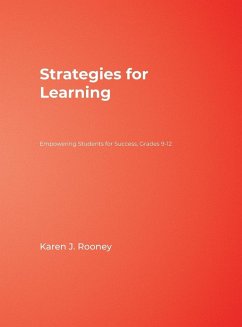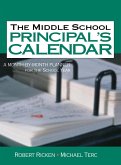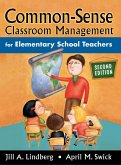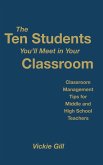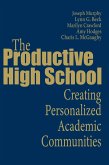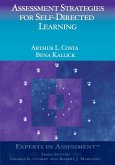- Gebundenes Buch
- Merkliste
- Auf die Merkliste
- Bewerten Bewerten
- Teilen
- Produkt teilen
- Produkterinnerung
- Produkterinnerung
These explicit, reiterative strategies improve motivation, help struggling students "learn how to learn," and provide them with an effective skill set for all content areas.
Andere Kunden interessierten sich auch für
![The Middle School Principal's Calendar The Middle School Principal's Calendar]() Robert RickenThe Middle School Principal's Calendar83,99 €
Robert RickenThe Middle School Principal's Calendar83,99 €![Common-Sense Classroom Management for Elementary School Teachers Common-Sense Classroom Management for Elementary School Teachers]() Jill A. LindbergCommon-Sense Classroom Management for Elementary School Teachers67,99 €
Jill A. LindbergCommon-Sense Classroom Management for Elementary School Teachers67,99 €![Understanding How School Change Really Happens Understanding How School Change Really Happens]() Rosetta M. CohenUnderstanding How School Change Really Happens53,99 €
Rosetta M. CohenUnderstanding How School Change Really Happens53,99 €![The Ten Students You'll Meet in Your Classroom The Ten Students You'll Meet in Your Classroom]() Vickie GillThe Ten Students You'll Meet in Your Classroom62,99 €
Vickie GillThe Ten Students You'll Meet in Your Classroom62,99 €![The Productive High School The Productive High School]() Joseph MurphyThe Productive High School80,99 €
Joseph MurphyThe Productive High School80,99 €![The Road to Open and Healthy Schools The Road to Open and Healthy Schools]() Wayne K. HoyThe Road to Open and Healthy Schools58,99 €
Wayne K. HoyThe Road to Open and Healthy Schools58,99 €![Assessment Strategies for Self-Directed Learning Assessment Strategies for Self-Directed Learning]() Arthur L. CostaAssessment Strategies for Self-Directed Learning34,99 €
Arthur L. CostaAssessment Strategies for Self-Directed Learning34,99 €-
-
-
These explicit, reiterative strategies improve motivation, help struggling students "learn how to learn," and provide them with an effective skill set for all content areas.
Produktdetails
- Produktdetails
- Verlag: Corwin
- Seitenzahl: 160
- Erscheinungstermin: 10. Dezember 2009
- Englisch
- Abmessung: 286mm x 221mm x 13mm
- Gewicht: 680g
- ISBN-13: 9781412972857
- ISBN-10: 141297285X
- Artikelnr.: 27181027
- Herstellerkennzeichnung
- Libri GmbH
- Europaallee 1
- 36244 Bad Hersfeld
- gpsr@libri.de
- Verlag: Corwin
- Seitenzahl: 160
- Erscheinungstermin: 10. Dezember 2009
- Englisch
- Abmessung: 286mm x 221mm x 13mm
- Gewicht: 680g
- ISBN-13: 9781412972857
- ISBN-10: 141297285X
- Artikelnr.: 27181027
- Herstellerkennzeichnung
- Libri GmbH
- Europaallee 1
- 36244 Bad Hersfeld
- gpsr@libri.de
Karen J. Rooney is Director of Educational Enterprises, Inc. in Richmond, Virginia. She earned her Ph.D. in Special Education at the University of Virginia (major areas: special education, psychology, research) and holds licenses in English, grades 7-12 in New York State and English, grades 7-12, as well as Learning Disabilities, grades K-12 in Virginia. Karen has taught in both private and public sectors and was the educational specialist in a multi-disciplinary clinic before becoming Director of The Learning Resource Center and founder of The Attention Disorders Clinic. She is a past member of the national board of the International Dyslexia Association and is the 2007 recipient of the Rebecca Brock Richardson award. Karen was selected to present a white paper on the importance of clinical judgment at the Learning Disabilities Summit in 2001, was a representative on the National Joint Committee on Learning Disabilities, served as the Children′s Action Network representative for the Division for Learning Disabilities of the Council for Exceptional Children (CEC) and participated in the Expert Work Group to develop CEC′s position regarding Response-to-Intervention. She currently is Past-President of the Division for Learning Disabilities of the Council for Exceptional Children and serves on the Steering Committee of the National Adolescent Literacy Coalition. On a daily basis, Karen provides direct services to children, adolescents and adults who need to improve their performance. She conducts assessments, provides educational consultation and teaches the program entitled Independent Strategies for Efficient Study. She also provides professional development on topics related to literacy skill development, learning disabilities, attention disorders, strategy training and response-to-intervention.
Preface
Acknowledgments
About the Author
1. Introduction
Before Reading This Book
Before Teaching the Strategies
General Principles, Techniques, and Important Concepts
Part I. Vocabulary and Note Taking When Reading
2. Vocabulary
Learning Vocabulary
3. Note Taking When Reading Material With Subtitles (Textbooks, Handouts,
and Web Site Material)
Card Format
Paper/Column Format
4. Note Taking Using Shortcut Advance Organizers
Shortcut Advance Organizer: Using Cards
Shortcut Advance Organizer: Using Paper/Columns
5. Note Taking for Material Without Subtitles (Teacher Handouts, Review
Sheets, or Class Notes)
Card Format
Paper/Column Format
6. Visual Organizers for Note Taking
Wheels for Reading
Wheels for Literature
7. Additional Reading Strategies
Literature Grids or Columns
Notation Strategy for Literature
Margin Notes
Sticky-Note Strategy
Page Note Taking
Part II. Note Taking When Listening
8. Note Taking During Oral Instruction or Lecture
Streamlined Note Taking (for Lecture)
Two-Column Note Taking (for Use in Content-Area Subjects)
Reduced Note Taking
9. Additional Note-Taking Strategies
Note Taking From Visuals (Blackboard, Projector, or PowerPoint)
Wheels for Note Taking
Note-Taking Grid Advance Organizer
Using Pictorials During Note Taking
Using Pictorials After Note Taking
Note Taking During Math Class
Reorganization of Notes After Class
Part III. Language Arts
10. Decoding and Spelling
Decoding
Spelling
11. English Grammar
Concept or Rule Cards: Option One
Concept or Rule Cards: Option Two
Personal Review Journal
12. Writing
Sentence-Building Strategy (Syntax)
Wheels for Writing
Part IV. Math and Foreign Language
Proofing for Errors
Upgrade Proofing
Wheels for Speech Writing
13. Mathematics
Concept, Rule, or Problem Type Cards
Personal Review Book or Journal
Word Problems
14. Foreign Language
Vocabulary
Chart Cards
Concept, Rule, or Topic Cards
Personal Grammar Review Book or Journal
Part V. Test Taking
15. Test Preparation and Test Taking
Imagery
Pretest Preparation
General Review
Vocabulary Review
Shortcut Review From Notes
Essay Test Review Using End-of-Chapter Questions
Reviewing Old Tests
Sudden-Death Review
Practice-Test Strategies (Conten-Area Subjects)
Practice-Test Strategy for Math, Foreign Language, and English Grammar
Question Strategies
Test-Taking Vocabulary
After-the-Test Strategy
Part VI. Organization, Time Management, and Solving Problems
16. Organization
Notebook Organization: Self-Containted Notebook
Backpack Organization
Self-Monitoring Strategies
Self-Graphing of Grades or Performance
Individualized Homework Assignment Planner
Strategies for Following Directions
17. Time Management
Sunday-Night Planning Overview
Homework, Activities, and Exam Review for a Semester
Time Management of Weekly Homework
Other Examples
18. Problem Solving
Wheels for Problem Solving
Wheels for Feelings
19. Conclusion
Resources
A. How to Help Students Choose an Appropriate Strategy
B. List of Well-Known Literacy Remediation Programs
C. List of Helpful Special Education Resources for Teachers
D. Glossary
Index
Acknowledgments
About the Author
1. Introduction
Before Reading This Book
Before Teaching the Strategies
General Principles, Techniques, and Important Concepts
Part I. Vocabulary and Note Taking When Reading
2. Vocabulary
Learning Vocabulary
3. Note Taking When Reading Material With Subtitles (Textbooks, Handouts,
and Web Site Material)
Card Format
Paper/Column Format
4. Note Taking Using Shortcut Advance Organizers
Shortcut Advance Organizer: Using Cards
Shortcut Advance Organizer: Using Paper/Columns
5. Note Taking for Material Without Subtitles (Teacher Handouts, Review
Sheets, or Class Notes)
Card Format
Paper/Column Format
6. Visual Organizers for Note Taking
Wheels for Reading
Wheels for Literature
7. Additional Reading Strategies
Literature Grids or Columns
Notation Strategy for Literature
Margin Notes
Sticky-Note Strategy
Page Note Taking
Part II. Note Taking When Listening
8. Note Taking During Oral Instruction or Lecture
Streamlined Note Taking (for Lecture)
Two-Column Note Taking (for Use in Content-Area Subjects)
Reduced Note Taking
9. Additional Note-Taking Strategies
Note Taking From Visuals (Blackboard, Projector, or PowerPoint)
Wheels for Note Taking
Note-Taking Grid Advance Organizer
Using Pictorials During Note Taking
Using Pictorials After Note Taking
Note Taking During Math Class
Reorganization of Notes After Class
Part III. Language Arts
10. Decoding and Spelling
Decoding
Spelling
11. English Grammar
Concept or Rule Cards: Option One
Concept or Rule Cards: Option Two
Personal Review Journal
12. Writing
Sentence-Building Strategy (Syntax)
Wheels for Writing
Part IV. Math and Foreign Language
Proofing for Errors
Upgrade Proofing
Wheels for Speech Writing
13. Mathematics
Concept, Rule, or Problem Type Cards
Personal Review Book or Journal
Word Problems
14. Foreign Language
Vocabulary
Chart Cards
Concept, Rule, or Topic Cards
Personal Grammar Review Book or Journal
Part V. Test Taking
15. Test Preparation and Test Taking
Imagery
Pretest Preparation
General Review
Vocabulary Review
Shortcut Review From Notes
Essay Test Review Using End-of-Chapter Questions
Reviewing Old Tests
Sudden-Death Review
Practice-Test Strategies (Conten-Area Subjects)
Practice-Test Strategy for Math, Foreign Language, and English Grammar
Question Strategies
Test-Taking Vocabulary
After-the-Test Strategy
Part VI. Organization, Time Management, and Solving Problems
16. Organization
Notebook Organization: Self-Containted Notebook
Backpack Organization
Self-Monitoring Strategies
Self-Graphing of Grades or Performance
Individualized Homework Assignment Planner
Strategies for Following Directions
17. Time Management
Sunday-Night Planning Overview
Homework, Activities, and Exam Review for a Semester
Time Management of Weekly Homework
Other Examples
18. Problem Solving
Wheels for Problem Solving
Wheels for Feelings
19. Conclusion
Resources
A. How to Help Students Choose an Appropriate Strategy
B. List of Well-Known Literacy Remediation Programs
C. List of Helpful Special Education Resources for Teachers
D. Glossary
Index
Preface
Acknowledgments
About the Author
1. Introduction
Before Reading This Book
Before Teaching the Strategies
General Principles, Techniques, and Important Concepts
Part I. Vocabulary and Note Taking When Reading
2. Vocabulary
Learning Vocabulary
3. Note Taking When Reading Material With Subtitles (Textbooks, Handouts,
and Web Site Material)
Card Format
Paper/Column Format
4. Note Taking Using Shortcut Advance Organizers
Shortcut Advance Organizer: Using Cards
Shortcut Advance Organizer: Using Paper/Columns
5. Note Taking for Material Without Subtitles (Teacher Handouts, Review
Sheets, or Class Notes)
Card Format
Paper/Column Format
6. Visual Organizers for Note Taking
Wheels for Reading
Wheels for Literature
7. Additional Reading Strategies
Literature Grids or Columns
Notation Strategy for Literature
Margin Notes
Sticky-Note Strategy
Page Note Taking
Part II. Note Taking When Listening
8. Note Taking During Oral Instruction or Lecture
Streamlined Note Taking (for Lecture)
Two-Column Note Taking (for Use in Content-Area Subjects)
Reduced Note Taking
9. Additional Note-Taking Strategies
Note Taking From Visuals (Blackboard, Projector, or PowerPoint)
Wheels for Note Taking
Note-Taking Grid Advance Organizer
Using Pictorials During Note Taking
Using Pictorials After Note Taking
Note Taking During Math Class
Reorganization of Notes After Class
Part III. Language Arts
10. Decoding and Spelling
Decoding
Spelling
11. English Grammar
Concept or Rule Cards: Option One
Concept or Rule Cards: Option Two
Personal Review Journal
12. Writing
Sentence-Building Strategy (Syntax)
Wheels for Writing
Part IV. Math and Foreign Language
Proofing for Errors
Upgrade Proofing
Wheels for Speech Writing
13. Mathematics
Concept, Rule, or Problem Type Cards
Personal Review Book or Journal
Word Problems
14. Foreign Language
Vocabulary
Chart Cards
Concept, Rule, or Topic Cards
Personal Grammar Review Book or Journal
Part V. Test Taking
15. Test Preparation and Test Taking
Imagery
Pretest Preparation
General Review
Vocabulary Review
Shortcut Review From Notes
Essay Test Review Using End-of-Chapter Questions
Reviewing Old Tests
Sudden-Death Review
Practice-Test Strategies (Conten-Area Subjects)
Practice-Test Strategy for Math, Foreign Language, and English Grammar
Question Strategies
Test-Taking Vocabulary
After-the-Test Strategy
Part VI. Organization, Time Management, and Solving Problems
16. Organization
Notebook Organization: Self-Containted Notebook
Backpack Organization
Self-Monitoring Strategies
Self-Graphing of Grades or Performance
Individualized Homework Assignment Planner
Strategies for Following Directions
17. Time Management
Sunday-Night Planning Overview
Homework, Activities, and Exam Review for a Semester
Time Management of Weekly Homework
Other Examples
18. Problem Solving
Wheels for Problem Solving
Wheels for Feelings
19. Conclusion
Resources
A. How to Help Students Choose an Appropriate Strategy
B. List of Well-Known Literacy Remediation Programs
C. List of Helpful Special Education Resources for Teachers
D. Glossary
Index
Acknowledgments
About the Author
1. Introduction
Before Reading This Book
Before Teaching the Strategies
General Principles, Techniques, and Important Concepts
Part I. Vocabulary and Note Taking When Reading
2. Vocabulary
Learning Vocabulary
3. Note Taking When Reading Material With Subtitles (Textbooks, Handouts,
and Web Site Material)
Card Format
Paper/Column Format
4. Note Taking Using Shortcut Advance Organizers
Shortcut Advance Organizer: Using Cards
Shortcut Advance Organizer: Using Paper/Columns
5. Note Taking for Material Without Subtitles (Teacher Handouts, Review
Sheets, or Class Notes)
Card Format
Paper/Column Format
6. Visual Organizers for Note Taking
Wheels for Reading
Wheels for Literature
7. Additional Reading Strategies
Literature Grids or Columns
Notation Strategy for Literature
Margin Notes
Sticky-Note Strategy
Page Note Taking
Part II. Note Taking When Listening
8. Note Taking During Oral Instruction or Lecture
Streamlined Note Taking (for Lecture)
Two-Column Note Taking (for Use in Content-Area Subjects)
Reduced Note Taking
9. Additional Note-Taking Strategies
Note Taking From Visuals (Blackboard, Projector, or PowerPoint)
Wheels for Note Taking
Note-Taking Grid Advance Organizer
Using Pictorials During Note Taking
Using Pictorials After Note Taking
Note Taking During Math Class
Reorganization of Notes After Class
Part III. Language Arts
10. Decoding and Spelling
Decoding
Spelling
11. English Grammar
Concept or Rule Cards: Option One
Concept or Rule Cards: Option Two
Personal Review Journal
12. Writing
Sentence-Building Strategy (Syntax)
Wheels for Writing
Part IV. Math and Foreign Language
Proofing for Errors
Upgrade Proofing
Wheels for Speech Writing
13. Mathematics
Concept, Rule, or Problem Type Cards
Personal Review Book or Journal
Word Problems
14. Foreign Language
Vocabulary
Chart Cards
Concept, Rule, or Topic Cards
Personal Grammar Review Book or Journal
Part V. Test Taking
15. Test Preparation and Test Taking
Imagery
Pretest Preparation
General Review
Vocabulary Review
Shortcut Review From Notes
Essay Test Review Using End-of-Chapter Questions
Reviewing Old Tests
Sudden-Death Review
Practice-Test Strategies (Conten-Area Subjects)
Practice-Test Strategy for Math, Foreign Language, and English Grammar
Question Strategies
Test-Taking Vocabulary
After-the-Test Strategy
Part VI. Organization, Time Management, and Solving Problems
16. Organization
Notebook Organization: Self-Containted Notebook
Backpack Organization
Self-Monitoring Strategies
Self-Graphing of Grades or Performance
Individualized Homework Assignment Planner
Strategies for Following Directions
17. Time Management
Sunday-Night Planning Overview
Homework, Activities, and Exam Review for a Semester
Time Management of Weekly Homework
Other Examples
18. Problem Solving
Wheels for Problem Solving
Wheels for Feelings
19. Conclusion
Resources
A. How to Help Students Choose an Appropriate Strategy
B. List of Well-Known Literacy Remediation Programs
C. List of Helpful Special Education Resources for Teachers
D. Glossary
Index

